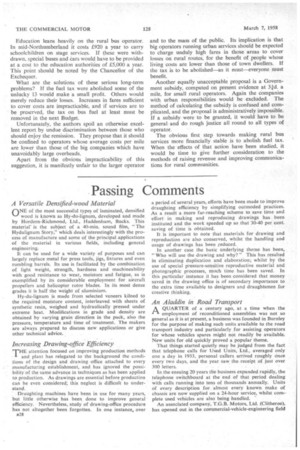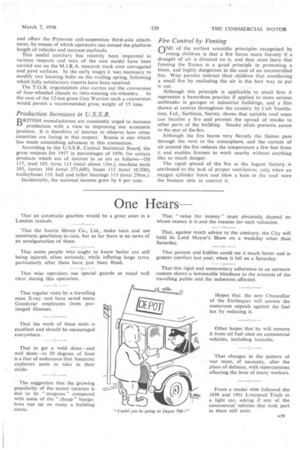Passing Comments
Page 38

Page 39

If you've noticed an error in this article please click here to report it so we can fix it.
A Versatile Densified-wood Material
rINE of the most successful types of laminated, densified
wood is known as Hy-du-lignum, developed and made by Hordem-Richmond, Ltd., Haddenham, Rucks. This material' is the subject of a 40-min. sound film, "The Hydulignum Story," which deals interestingly with the process of manufacture and some of the principal applications of the material in various fields, including general engineering.
It can be used for a wide variety of purposes and can largely replace metal for press tools, jigs, fixtures and even rumbling barrels. Its use is facilitated by the combination of light weight, strength, hardness and machineability with good resistance to wear, moisture and fatigue, as is exemplified by its considerable employment for aircraft propellers and helicopter rotor blades. In its most dense grades it is half the weight of aluminium.
Hy-du-lignum is made from selected veneers kilned to the required moisture content, interleaved with sheets of synthetic resin, weighed and hydraulically pressed under extreme heat. Modifications in grade and density are obtained by varying grain direction in the pack, also the pressure, temperature and time of treatment. The makers are always prepared to discuss new applications or give other technical advice.
Increasing Drawing-office Efficiency
THE attention focused on improving production methods and plant has relegated to the background the conditions of the design and drawing office attached to every manufacturing establishment, and has ignored the possibility of the same advance in techniques as has been applied to production. As drawings are essential before production can be even considered; this neglect is difficult to understand.
Draughting machines have been in use for many years, but little otherwise has been done to improve general efficiency. Nevertheless, study of drawing-office procedure has not altogether been forgotten. In one instance, over B28 a period of several years, efforts have been made to improve draughting efficiency by simplifying outmoded practices. As a result a more far-reaching scheme to save time and effort in making and reproducing drawings has been instituted and the work speeded up so that 30-40 per cent. saving of time is obtained.
It is important to note that materials for drawing and reproduction are also conserved, whilst the handling and usage of drawings has been reduced.
In another case the basic underlying theme has been, "Who will use the drawing and why?" This has resulted in eliminating duplication and elaboration; whilst by the use of special pressure-sensitive reproductive material and photographic processes, much time has been saved. In this particular instance it has beers considered that money saved in the drawing office is of secondary importance to the extra time available to designers and draughtsmen for creative thinking.
An Aladdin in Road Transport
AQUARTER of a century ago, at a time when the employment of reconditioned assemblies was not so general as it is at present, a business was founded in Burnley for the purpose of making such units available to the road transport industry and particularly for assisting operators for whose vehicles spares might not readily be available. New units for old quickly proved a popular theme.
That things started quietly may be judged from the fact that telephone calls for Used Units, Ltd., averaged only one a day in 1933, personal callers arrived roughly once every two days, and the year saw thereceipt of just over 300 letters.
In the ensuing 20 years the business expanded rapidly, the telephone switchboard at the end of that period dealing with calls running into tens of thousands annually. Units Of every description for. almost every known make of chassis are now supplied on a 24-hour service, whilst corn-• plete used vehicles are also being handled.
An associated company, T.G.B. Motors, Ltd. (Clitheroe), has opened out in the commercial-vehicle-engineering field
and offers the Primrose coil-suspension third-axle attachment, by means of which operators can extend the platform length of vehicles and increase payloads.
This useful auxiliary has recently been improved in various respects and tests of the new model have been carried out on the M.I.R.A. research track over corrugated and pave surfaces. In the early stages it was necessary to modify two locating bolts on the trailing spring, following which fully satisfactory reports have been received.
The T.G.B. organization also carries out the conversion of four-wheeled chassis to twin-steering six-wheelers. In the case of the 12-ton gross Guy Warrior such a conversion would permit a recommended gross, weight of 15 tons.
Production Increases in U.S.S.R.
BRITISH manufacturers are constantly urged to increase
production with a view to improving our economic position. It is therefore of interest to observe how other countries are faring in this respect. Russia is one which has made astonishing advances in this connection.
According to the U.S.S.R. Central Statistical Board, the gross outputs for 1957 in percentages of 1956, for certain products which are of interest to us are as follows—Oil 117, steel 105, tyres 113 (total about 13m.), machine tools 105, lorries 104 (total 371,600), buses 112 (total 10,300), trolleybuses 119, ball and roller bearings 113 (total 296m.).
Incidentally, the national income grew by 6 per cent.
Fire Control by Venting
0NE of the earliest scientific principles recognized by young children is that a fire burns more fiercely if a draught of air is directed on it, and they soon learn that fanning the flames is a good principle in promoting a blaze, and highly dangerous in the case of an uncontrolled fire. Wise parents instruct their children that smothering a small fire by excluding the air is the best way to put it out.
Although this principle is applicable to small fires it represents a hazardous practice if applied to more serious outbreaks in garages or industrial buildings, and a film shown at centres throughout the country by. Colt Ventilation, Ltd., SUrbiton, Surrey, shows that suitable roof vents can localize a fire and prevent the spread of smoke to other parts of the building. Smoke often prevents access to the seat of the fire.
Although the fire burns very fiercely the flames pass through the vent to the atmosphere, and the curtain of air around the fire reduces the temperature a few feet from it and enables firemen to work nearby without anything like so much danger.
The rapid spread of the fire at the Jaguar factory is attributed to the lack of proper ventilation; only when an oxygen cylinder burst and blew a hole in the roof were the firemen able to control it.
























































































































